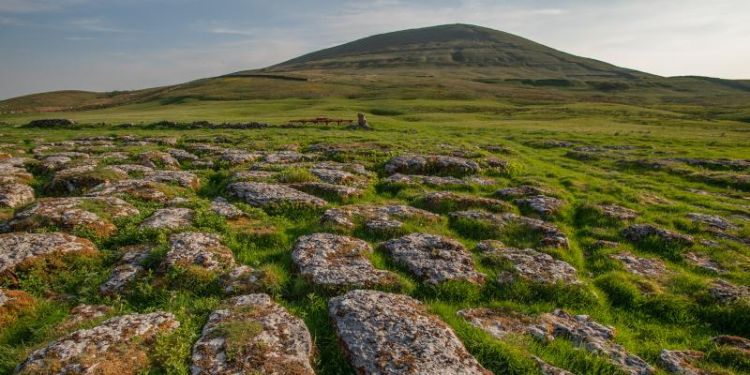A wilder future for Yorkshire

A new flagship restoration project showcasing an alternative future for the UK's uplands has been launched.
Wild Ingleborough aims to restore an iconic area in the heart of the Yorkshire Dales National Park, around Ingleborough – the second highest peak in the Dales.
The project is a partnership between the University, WWF, Yorkshire Wildlife Trust, Natural England, the United Bank of Carbon and The Woodland Trust.
It promises to be an important venture for people, nature and climate – working together with local communities including farmers to share skills and knowledge that will create a wilder future for Ingleborough.
The striking landscape includes swathes of bare limestone pavement and heavily grazed pasture. But in the future, the area will be transformed into a nature-rich haven, with a variety of rare flora and fauna to benefit from the restoration of their natural habitats.
Creating new woodlands is a critical component of efforts to mitigate climate change and reach net-zero.
Scientific monitoring, overseen by a research team from Leeds, will enable the project to track changes to the landscape over time.
Crucially, this monitoring will help the project team understand the way that moving to less intensive land management affects, for example, biodiversity and carbon storage across this landscape.
This scientific underpinning will provide an evidence-base for new policy to benefit rural communities and boost the recovery of UK nature.
Managing landscapes
Research team member Professor Dominick Spracklen, from Leeds’ School of Earth and Environment, said: “A major challenge facing society is how to manage our landscapes in a way that allows nature to thrive and helps address climate change at the same time as producing food.
“We will embed monitoring in the project from the outset, allowing us to demonstrate the benefits of Wild Ingleborough for nature, climate and people.”
Covering an area from the River Ribble up towards the mountain summit, Wild Ingleborough will see the restoration of peatlands and the expansion of native woodland and scrub, to remove and store carbon, helping to tackle the climate crisis.
The project will initially cover 1,200 hectares and plans to be one of the first examples in England of re-establishing the natural tree line, from broadleaf woodland to dwarf shrub, heather moorland and lichen heathlands.
Dr Cat Scott, Director of the Leeds Ecosystem, Atmosphere and Forest (LEAF) Centre at Leeds, and Scientific Lead for the United Bank of Carbon, said: “Creating new woodlands is a critical component of efforts to mitigate climate change and reach net-zero.
“Upland areas of the UK currently have very little woodland cover. Where appropriate, we need to find ways to create more native woodland in these landscapes to help address climate change at the same time as benefitting nature and people.
“Wild Ingleborough will showcase the benefits of upland native woodland and provide vital new evidence around how we can best increase carbon storage and reverse the biodiversity decline across UK landscapes.”
More space for wildlife
The programme will connect existing nature reserves in the area, creating a bigger, more joined up space for wildlife.
In some places, vegetation will regenerate naturally, while in others the project will connect areas of woodland through tree planting.
Over the next 12 months, the project will create around 40 hectares of new native woodland, with half created by planting 30,000 trees and the other half through natural regeneration.
By aiding nature’s recovery, the project hopes to protect and restore wildlife-friendly habitats, home to precious animal species including black grouse, red squirrel, cuckoos and curlew – of which there are currently only two pairs within the Ingleborough project area.
The programme will also focus on plants such as juniper - most of which around Ingleborough have suffered from disease – as well as bird’s-eye primrose, globeflower and the nine species of fern that can be found in the area.
In recent decades, intensive land use has had a heavy impact on the area, but now, as well as restoring the habitats of plants and animals, Wild Ingleborough will also help to protect against flooding, and improve the water and soil of the landscape.
The project will work closely with local landowners, farmers and other members of the community to share knowledge of nature conservation as well as low-intensity farming practices.
Nature at heart
Already, 300 hectares of land are being restored as part of the first phase of the project, with 3,000 native trees planted, including rowan, hawthorn and hazel, and hundreds of metres of drystone wall rebuilt.
Tanya Steele, Chief Executive at WWF, said: “Climate change and nature loss are two sides of the same coin; it’s vital that any efforts to safeguard our future and stabilise our climate have nature at their heart.
“The UK, as hosts of COP26, can lead efforts to boost nature’s recovery, including transforming the way we use our land – with Wild Ingleborough a blueprint for restoration.
“Through this project, we want to show that a wilder world is a more stable one, with nature more resilient and able to adapt to change.
“Together with our partners and the local community, we hope to create a rich, diverse landscape for people and wildlife to thrive.”
Rachael Bice, chief executive at Yorkshire Wildlife Trust, said: “Ingleborough is one of the most iconic and cherished landscapes in our great county.
“The opportunity to support nature to flourish here is something we are incredibly proud to be involved in.
“By intervening carefully, we will see the landscape of the Dales transform - restoring natural process and communities of plants and animals, which will help to secure and enrich the future of Yorkshire’s residents and visitors too.”
Further information
Main picture: Yorkshire Dales at Ingleborough. Credit Andrew Parkinson WWF UK.
Second picture: Adobe Stock.




